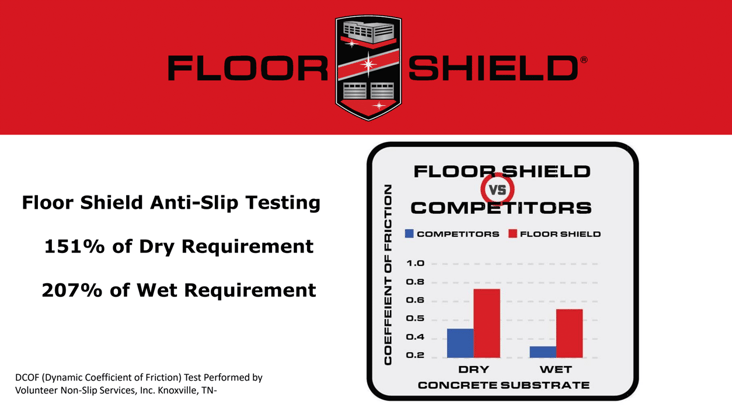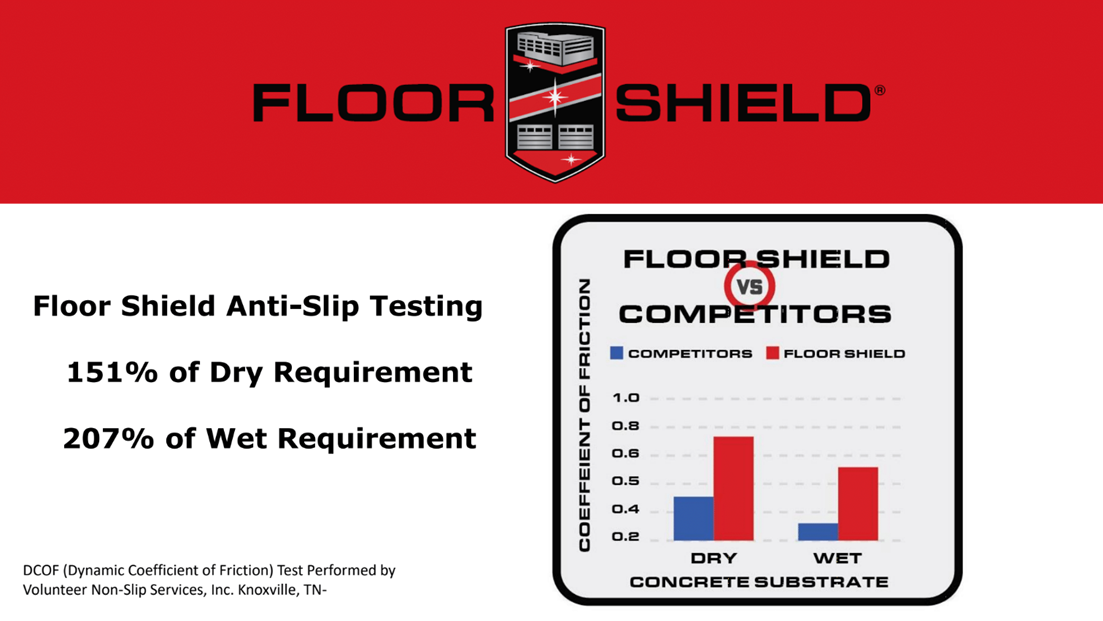In the world of flooring, one of the most significant concerns is the potential for slip and fall accidents. Smooth surfaces inherently have lower friction, making them more susceptible to slipperiness, especially when wet. This is a problem frequently encountered on concrete floors, which can become even more treacherous in rainy or wet conditions.
This leads people to ask us at Floor Shield, “Are concrete coatings more slip-prone than bare concrete?” and “If they aren’t, what makes them slip-resistant despite the smoother surface profile?”
We want to ensure that we answer both questions honestly and thoroughly, as the consequences of slip and fall accidents can be severe, leading to potential:
- Injuries
- Liability issues
- Substantial financial burdens
Therefore, it’s crucial to address this issue, and concrete coatings have emerged as a more and more viable solution with each new advancement in the various coating formulas.
WHAT IS THE COEFFICIENT OF FRICTION?
In physics, the coefficient of friction is a key parameter used to measure the resistance to motion between two surfaces concerning the force of gravity holding them together. This coefficient is expressed as a number between 0 and 1, where larger numbers indicate higher slip resistance.
When assessing the slip resistance of concrete floors, the Occupational Safety and Health Administration (OSHA) evaluates two key numbers: one for dry conditions and another for wet conditions. Achieving OSHA’s standards for wet conditions is particularly challenging, as they involve introducing not only water but also a bit of oil to intensify slipperiness.
The national standard for a non-slip floor is typically set at 0.42, meaning that on a non-slip floor, at least 42% of one’s weight must be converted into grip between the shoes and the floor. Polished concrete floors, however, often boast coefficients of friction ranging from 0.49 to 0.59, depending on the installation details. This significant increase in slip resistance makes polished concrete floors 20% to 50% more slip-resistant than the national standard for a low-slip floor.
Floor Shield surpasses these numbers significantly. When we tested our 100% polyaspartic concrete coating under OSHA, our results came in as follows:

ARE POLISHED FLOORS THE BEST FOR NON-SLIP?
Research suggests polished concrete to be on average the most slip-resistant variation of concrete flooring. This is attributed to the non-slip wax that is typically mixed in with the polish formula. This wax wears off over time, though. Eventually, the floor will become more slippery than regular concrete. This is why many businesses will re-polish their floors every year.
If you want to polish your floor, it’s important to understand that regular re-polishing is required to maintain a safe area and sheen. This will run up your expenses very quickly, which is why polished floors are mostly only recommended for non-residential use.
Most businesses are willing to endure this expense because slip-related injuries are a frequent occurrence in the United States, with businesses shouldering an annual cost exceeding $80 billion due to slip and fall accidents. Preventing these accidents is not only ethically responsible but also financially beneficial.
HOW AGGREGATES MAKE CONCRETE COATINGS NON-SLIP
After polished concrete, concrete coatings come in as the best option to make your floor non-slip. And unlike polished concrete, they don’t require frequent re-coating to keep them slip-resistant. The main contributor to the non-slip properties of any concrete coating lies in the aggregates producers will add to the formulas.
Many companies are also always improving how they incorporate these aggregates. For instance, Floor Shield used to sprinkle aggregates on top of the still uncured clear coat, but now, we’ve developed a more effective method of mixing them into the clear coat before application. This approach ensures a more even distribution of aggregates, improving the overall slip resistance.
The choice of aggregate can significantly impact slip resistance. While aluminum oxide is the most common and affordable aggregate, it tends to settle at the bottom of the coating, reducing its anti-slip effects. Additionally, aluminum oxide can matte the coating’s finish, reducing the vibrance of the floor’s color and sheen.
Aggregates like silica are preferred alternatives because they do not settle as easily and do not significantly matte the floor. This is precisely why we use them in our coating.
However, there is a delicate balance to be maintained when adding aggregates. Adding too many can compromise the gloss of the final product, resulting in a matte appearance. This trade-off is essential because shinier floors are inherently more prone to slipperiness. So, it’s crucial to strike the right balance between gloss and slip resistance.
This is why Floor Shield constantly runs internal tests where we try to add as many of our aggregates as possible without deterring the sheen of the final product.
WHAT IS THE BEST SLIP-RESISTANT CONCRETE COATING?
Different types of concrete coatings offer varying levels of slip resistance. Epoxy, for instance, is more slip-prone than other common types of coatings like polyurea and polyaspartic due to its extended drying time, resulting in a slick and glossy surface. This happens because the solid content of the resin slowly sinks closer to the bottom of the coating while the product is still drying, which makes the solid textures have less grab on the surface. Additional aggregates are necessary to mitigate this issue.
Polyurea is less slippery than epoxy, drying in half the time. However, polyaspartic coatings are the least inherently slippery concrete coatings, primarily due to their quick drying time and a slight grip resulting from its inherent chemical makeup. Moreover, polyaspartic coatings are thinner than epoxies and polyurea, allowing for better retention of the concrete’s texture, which enhances traction.
Most concrete coating systems utilize acrylic flakes to add further texture to the floor. This also aids the floor’s aesthetic, as there are typically many color options with flakes.
WHAT IS CONCRETE SEALING?
Like with both concrete coating and polishing, concrete sealing is a process involving grinding the concrete surface about 8x over. The grinding process gets progressively finer with each layer to create as smooth a substrate as possible. Then, a specific sealer is applied.
Sealers are commonly used to protect concrete from:
- Stains
- Simplify cleaning
- Water damage
However, this process can sometimes make the floor more slick, particularly in northern regions where it gets colder. To combat this, businesses often add a wax layer to the sealer, reducing the slip-prone nature of the concrete sealer.
There’s a reason why concrete is more slip-prone in colder climates, and that has to do with how most outdoor concrete floors are made. Since concrete is porous, it naturally absorbs water. The problem with this is whenever water gets in these pores and freezes, the ice expands, cracking the concrete and even causing complete concrete failure. This process is referred to as the freeze-thaw cycle.
To combat this, northern regions make their concrete with smaller pores, resulting in harder concrete that is more slippery. This does not mean water doesn’t still cause damage, though. This is why many people still seal their concrete because it prevents potential water damage and helps with the harder concrete’s slip-prone surface.
It should be noted that concrete sealing is just that, it merely seals and protects. This means you’ll be left with the same dreary look that is oftentimes associated with bare concrete. If you are looking for a particular color or aesthetic, we recommend going with a concrete coating.
ARE ACRYLIC COATINGS SLIPPERY?
Acrylic coatings, being water-based, often have little to no texture or grip. These coatings are thick enough to retain the base texture of the paint, which is usually minimal, leading to a slip hazard.
An example of the potential danger we’ve come across was a Floor Shield customer in Florida who did his floor with acrylic paint that he bought from a big box store. Two days after the application, he slipped and fell on it, breaking his hip. He came to us, and we applied Floor Shield. He hasn’t had a slick floor problem since.
It’s essential to choose coatings wisely, as the wrong choice can result in hazardous conditions, as evidenced by this customer’s unfortunate experience. We recommend avoiding acrylic paint coats if you seek to optimize your safety.
OTHER BENEFITS OF CONCRETE COATINGS
Slip and fall accidents are a serious concern, both in terms of safety and potential liability. This is especially the case with slip-prone concrete. In general, coated concrete is more slip-resistant than bare concrete due to the incorporation of aggregates and flakes that enhance texture and grip. Plus, you get these additional benefits:
- Protects against water-related damage (mold, mildew, algae).
- Easier clean-up.
- Guards against surface blemishes from abrasion.
- Protects against cracking.
- Much more aesthetically appealing than bare concrete.
If you’re interested in potentially investing in a concrete floor, scroll down to get a free, no-obligation quote from Floor Shield.



